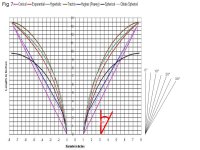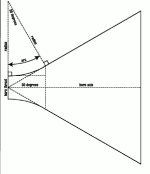Hey new member here.
Joined the form to ask if anyone has built any of Acoustic Horn's conical horns? It was a company owned by a person named Bill Woods who passed away I think a few years ago. He made and sold 300hz, 500hz, 700hz, and 1000hz horns. I was wondering if anyone here owned any or if they have built a set of them and can provide guidance. I'm trying to either get my hands on a pair or make them with some plans.
I hope everyone is have a good day.
Stu
Joined the form to ask if anyone has built any of Acoustic Horn's conical horns? It was a company owned by a person named Bill Woods who passed away I think a few years ago. He made and sold 300hz, 500hz, 700hz, and 1000hz horns. I was wondering if anyone here owned any or if they have built a set of them and can provide guidance. I'm trying to either get my hands on a pair or make them with some plans.
I hope everyone is have a good day.
Stu
Hi Stu,
I still have my AH!1000 horns. I haven't used them in a bit, I'm listening to the Jeff Bagby Zephyr design he did for DIYsoundgroup.
I didn't find conical horns to be much different than working with other horn shapes, all of them take some work to get them sounding right. I've always envied the big 300hz conicals, I've heard them a bunch of times, generally the OMA stuff, and always loved them.
Best of luck with your project. As an aside, Bill was a terribly nice and very helpful when I was knee-deep working with my AH!1000's.
Regards,
John
I still have my AH!1000 horns. I haven't used them in a bit, I'm listening to the Jeff Bagby Zephyr design he did for DIYsoundgroup.
I didn't find conical horns to be much different than working with other horn shapes, all of them take some work to get them sounding right. I've always envied the big 300hz conicals, I've heard them a bunch of times, generally the OMA stuff, and always loved them.
Best of luck with your project. As an aside, Bill was a terribly nice and very helpful when I was knee-deep working with my AH!1000's.
Regards,
John
Thanks John for your swift reply. I like the look of conical and I have the space so I thought it would be a fun experiment. Is it possible you can share the dimensions with me so I can have a starting point? I have some 1" and 1.4" compression drivers from all walks of life I want to test.
Have a good day.
Stu
Have a good day.
Stu
Unfortunately, they are boxed up in the attic so I can't measure them directly. But, there isn't a horn shape around that is easier to figure out the dimensions on. Mine are 60degress with a 1" throat. If I recall correctly, they are about 9 inches deep which would make the mouth about 10.5" in diameter (ignoring the roundover). On mine, the roundover is pretty modest, maybe an inch or two. I used them crossed over to 12" drivers, generally in the 1200-1500hz range.
Regards,
John
Regards,
John
Greets!
FWIW they were textbook design, so can design them with any horn calculator such as Hornresp or simple math, though due to beaming it's better to use Dr. Geddes' oblate spheroid + terminus roundover to at least 180 deg..
FWIW they were textbook design, so can design them with any horn calculator such as Hornresp or simple math, though due to beaming it's better to use Dr. Geddes' oblate spheroid + terminus roundover to at least 180 deg..
Attachments
If you ever want to sell them, let me know! Thank you for the information.Unfortunately, they are boxed up in the attic so I can't measure them directly. But, there isn't a horn shape around that is easier to figure out the dimensions on. Mine are 60degress with a 1" throat. If I recall correctly, they are about 9 inches deep which would make the mouth about 10.5" in diameter (ignoring the roundover). On mine, the roundover is pretty modest, maybe an inch or two. I used them crossed over to 12" drivers, generally in the 1200-1500hz range.
Regards,
John
Thanks for the geometry. DId you find this online or use a calculaor? Which calculator did you use if the latter?Greets!
FWIW they were textbook design, so can design them with any horn calculator such as Hornresp or simple math, though due to beaming it's better to use Dr. Geddes' oblate spheroid + terminus roundover to at least 180 deg..
I would also like to know how to Blend conical to OS at the throat as I believe you're right that this would yield better results.
Not quite in that for a given axial length the OS has a 'faster' flare' than conical. Bummer that it's so faint in my copy it's hard to see it clearly enough (closest to Hughs/Peavy) and don't remember nor can find ATM the who/what presentation it's from.How do you do that Greg? Blend conical to OS at the throat?



I checked my archives, and I have a copy of a XLS from the Geddes OS thread, in case it's not there anymore. I can't vouch for which revision it is. It doesn't have the roundover math.
EDIT: that's not the one you want. There's one that will let you specify the angle. Let me dig it up.
EDIT: that's not the one you want. There's one that will let you specify the angle. Let me dig it up.
Attachments
Last edited:
OS is 'conical' for all intents and purposes. You use it whenever you want conical but don't have the starting wavefront for it. The result will be equivalent to conical.
However at no point is it actually conical. If you want to blend one to the other you have to choose some point and glue them together. Working out a compromise requires an understanding of how it works, however just doing the throat seems a popular choice.
However at no point is it actually conical. If you want to blend one to the other you have to choose some point and glue them together. Working out a compromise requires an understanding of how it works, however just doing the throat seems a popular choice.
How would one now take this result in Autocad to draw a sketch of the arc needed? I am trying to solve the math for a 1.2khz horn for a 1" compression driver with that will be crossed over at 1.2khz.
 e
e
I insert the screenshot into an Autocad drawing, scale it and then draw a spline over it. A spline comprised of three points (including the ends) and two angles will probably be close enough.
Thanks Allen. What if I wanted to do a 1.4" driver that had a 80x40 coverage (not a round exit) where the horn would be wider than it is tall.
It helps to start with a goal for the sound, then find a horn that does it.
To answer your question it all depends on how far you want to compromise because designing non-axisymmetric waveguide accurately is quite complicated. For example it does not have a flat front unless you want to compromise the mouth.
In addition, 40 degrees will be large.
By all means try.. it's difficult to give a whole answer in one post.
To answer your question it all depends on how far you want to compromise because designing non-axisymmetric waveguide accurately is quite complicated. For example it does not have a flat front unless you want to compromise the mouth.
In addition, 40 degrees will be large.
By all means try.. it's difficult to give a whole answer in one post.
Of course I want to try it, I am a bored retired old man. What I am asking is I think if the throat is larger than 1" the arch of the excel needs to also extend beyond 1" and its not, correct? It should go to 1.4" but I am not sure how to indicate that using the excel. Maybe it's not possible there.
- Home
- Loudspeakers
- Multi-Way
- AH! Conical Horns

